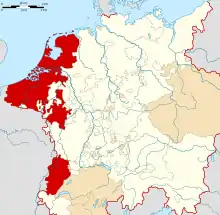County of Zeeland
The County of Zeeland (Dutch: Graafschap Zeeland) was a county of the Holy Roman Empire in the Low Countries. It covered an area in the Scheldt and Meuse delta roughly corresponding to the modern Dutch province of Zeeland. The County of Zeeland did not include the region of Zeelandic Flanders which was part of Flanders; conversely, the modern Province of Zeeland does not include Sommelsdijk, historically part of the County of Zeeland.
County of Zeeland | |||||||||
|---|---|---|---|---|---|---|---|---|---|
| 1012–1795 | |||||||||
 Coat of arms
| |||||||||
.svg.png.webp) The County of Zeeland around 1350. | |||||||||
| Status | State of the Holy Roman Empire (until 1581/1648) Province of the Dutch Republic (1581/1648-1795/) | ||||||||
| Capital | Middelburg | ||||||||
| Common languages | Dutch | ||||||||
| Religion | |||||||||
| Government | Feudal monarchy | ||||||||
| Historical era | Middle Ages, Renaissance, Modern | ||||||||
• Established | 1012 | ||||||||
• Held by Holland | 1323 | ||||||||
• To Burgundy | 1432 | ||||||||
• Joined Burgundian Circle | 1512 | ||||||||
• Part of Dutch Republic | 1581 | ||||||||
• Disestablished | 1795 | ||||||||
| |||||||||
History

Historically the area was often under the influence of its stronger neighbors, the County of Holland, the County of Hainaut and the County of Flanders. In 1012 Emperor Henry II the Saint enfeoffed the French count Baldwin IV of Flanders with Zeeland after which both counties were ruled in personal union, contested by northern Holland from the beginning. In 1167 a war broke out between the counties, after which Count Floris III of Holland had to acknowledge the overlordship of Count Philip of Flanders in Zeeland. Count Floris IV of Holland (1222-1234) reconquered Zeeland, which from the accession of Count Floris V, the son of William II of Holland, in 1256 was ruled in personal union by Holland.
By the 1323 Treaty of Paris between Flanders and Hainaut-Holland, the Count of Flanders reneged from claims on Zeeland and recognized the count of Holland as Count of Zeeland. Nevertheless, Zeeland remained a separate administrative unit, which in turn was under the administration of the counts of Holland. In 1432 it was annexed by the Burgundian duke Philip the Good and became part of the Burgundian Netherlands. After the death of Mary of Burgundy in 1482, Zeeland according to the Treaty of Senlis was one of the Seventeen Provinces held by the House of Habsburg, which in 1512 joined the Burgundian Circle.


After the Eighty Years' War, Zeeland was one of the United Provinces of the Dutch Republic established in 1581. Both before and after Dutch independence Zeeland shared some institutions with the States of Holland and West Friesland, such as the supreme court, the Supreme Council of Holland, Zeeland and West-Friesland, after the northern provinces had removed themselves from imperial authority and the jurisdiction of the Grand Council of Mechelen.
After establishment of the States-General of the Netherlands in 1583, Middelburg initially became the place of assembly. From 1585 on they were held in The Hague. As a (theoretically) independent (part) state the county Zealand ceased to exist under the Batavian Republic in 1795, when it became a département. Together with Zeelandic Flanders it today forms the province of Zeeland.
Rulers of Zeeland
| Counts of Flanders | 1012–1167 | |
| Condominium of the Counts of Flanders and Holland | 1167–1256 | |
| Counts of Holland and Zeeland | 1256–1572 | |
| States of Zeeland | 1572–1795 |
Cities in the County of Zeeland
Voting cities, in order of importance:
- Middelburg (1217)
- Zierikzee (1248)
- Reimerswaal (1374) until 1574 voting in the States of Zeeland,
- Goes (1405)
- Tholen (1366)
- Vlissingen (1315) voting in the States of Zeeland from 1574 on
- Veere (1355) voting in the States of Zeeland from 1574 on
Small Towns (no seat in the States of Zeeland):
- Arnemuiden (1574)
- Brouwershaven (1477)
- Domburg (1223)
- Kortgene (1431)
- Sint Maartensdijk (1491)
- Westkapelle (1223)
